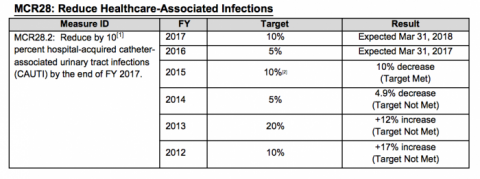- Home
- Agencies
- Department of Agriculture
- Department of Housing and Urban Development
- General Services Administration
- Department of Commerce
- Department of the Interior
- National Aeronautics and Space Administration
- Department of Defense
- Department of Justice
- National Science Foundation
- Department of Education
- Department of Labor
- Office of Personnel Management
- Department of Energy
- Department of State
- Small Business Administration
- Environmental Protection Agency
- Department of Transportation
- Social Security Administration
- Department of Health and Human Services
- Department of the Treasury
- U.S. Agency for International Development
- Department of Homeland Security
- Department of Veterans Affairs
- Goals
- Initiatives
- Programs
Improving Patient Safety by Reducing Healthcare-Associated Infections
What is the Issue?
At any given time, about one in every 25 hospitalized patients has a healthcare-associated infection (HAI) while over 1 million HAIs occur across the U.S. healthcare system every year. These infections can lead to significant morbidity and mortality, with tens of thousands of lives lost each year. Of these hospital-acquired events, catheter-associated urinary tract infections (CAUTI) are among the most common. Research has shown that a significant portion of these infections can be prevented, avoiding patient morbidity and mortality from this HAI while reducing costs accrued to the healthcare system.
What was the Intervention?
HHS used four primary strategies to make inroads into this area:
- Collaboration among multiple stakeholders in the healthcare community including quality improvement contractors, state health departments, state hospital associations, healthcare administrators and practitioners.
- Tracking and monitoring data that drives improvement
- Linking higher quality, safer, and more efficient care to payment
- Research and testing that refine evolving HAI prevention guidelines, optimize implementation strategies and tools, and integrate health information technology
How was performance management useful?
Through the Agency Priority Goal process and a broader Department initiative on healthcare-associated infections, the Centers for Medicare and Medicaid (CMS), Centers for Disease Control and Prevention (CDC), Agency for Healthcare Research and Quality (AHRQ) and others worked more closely together to bring the expertise of all groups to bear on the problem. With this structure developed in conjunction with Department leadership, these stakeholders used their combined knowledge and skills to develop, articulate, and disseminate evidence-based interventions to thousands of healthcare providers.
What was the impact?
Compared to the 2010 baseline, there has been a 21% reduction in overall harm in U.S. hospitals. This has resulted in an estimated 3 million fewer patients harmed, 125,000 lives saved, and nearly $28 billion in cost saving. For their work in this area, three CMS employees were awarded a Service to America Medal as Federal Employees of the Year in 2016.
[1] The FY2017 target is a 10% reduction equating to a national CAUTI SIR of 0.90 (from 1.0 to 0.90). CDC rest the national CAUTI SIR baseline to 1.0 in FY2015.
[2]The final CAUTI target will be 10% reduction in the national CAUTI SIR from baseline or a target SIR 0.93. (Note: the October 31, 2014 report noted an end CAUTI SIR of 1.02.)





